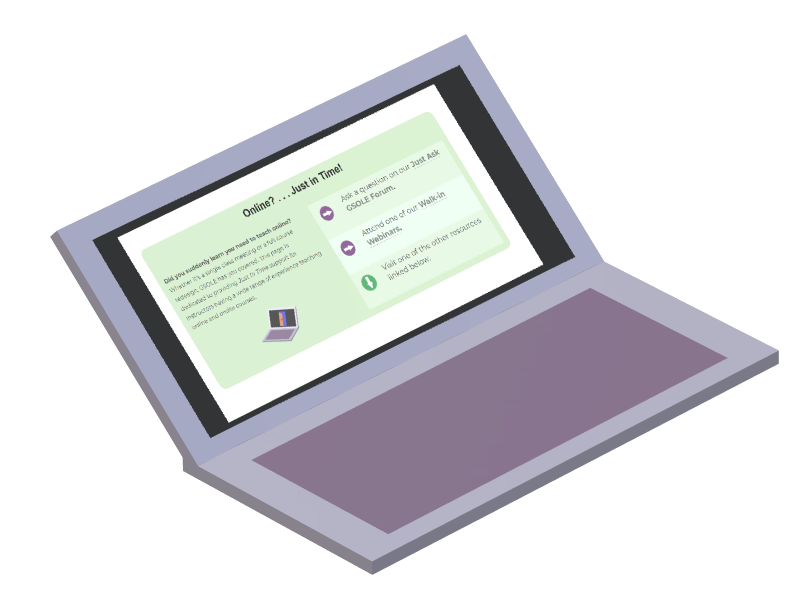Need to quickly convert to online? |
OverviewWe've all encountered days when our plans have been upended. Perhaps the weather has turned south, or maybe you have to stay home with a sick kid. For whatever reason you can't make it to campus, there are many ways to ensure that your class stays on track and that you maintain connections with students. |
|
Taking a Moment to ReflectYou likely already have a head start!You and your students have already established a working relationship in the face-to-face classroom. What's more, you're already an expert in your content area. While you may be just learning online teaching technologies, there are many people to help you with that, and your course may already be partly online.
What you need to focus on nowEmergencies or sudden conversions from face-to-face to online classes in themselves provide kairotic learning opportunities on information literacy. Moreover, virtual collaboration is an essential skill in today’s workplace, and online courses are ideal for helping students develop proficiency in this area. To turn this unexpected situation into a constructive learning experience, here are a few ways to direct your energy:
Preparing to ConvertBefore you can transition to an online format, you’ll need to determine the resources available, the needs of your students, and the limitations of what you can provide.
Creating the Online Classroom |
Resist the idea that “classroom” activities must be synchronous. Asynchronous activities work well in the online environment because you can be confident that students will always have access to all activities. Students may be dealing with added travel, hospital stays, or caring for family, so asynchronous options may allow students to balance added responsibilities and stresses in this emergency time—not to mention additional responsibilities faculty may face. You may need to find out what kind of access students will have to the internet, computers, and mobile devices.
How to maintain the semblance of regular class meetings
- Have activities due on regular class days
- Assign video lectures and/or send announcements on regular class days
- Schedule whole class or team video conferences during the regular class period
- Maintain the same office hours using chat, video-conference, or phone
How to lecture online
Note that these lectures do not need to be perfectly edited, award winning videos. They need to be clear and accessible to your students, but you should not devote hours upon hours to producing the perfect lecture video. For better results, follow these practices:
- Write out what you would normally discuss orally
- Record audio of your lectures
- Record video of your lecture (either with you onscreen or with your voiceover commentary on a slide presentation)
How to get the most out of recorded presentations
Pre-recorded lectures allow students to revisit those lectures as needed:
- Record in smaller segments so they are easier for you to produce and easier for students to take in and re-watch as needed.
- Make the video part of an assignment to ensure students watch. That is, ask them to discuss the video, ask a question, or perform some kind of activity based on the video.
- Ensure all materials are accessible to all students:
- Use closed captioning in videos or provide transcripts in videos
- Format text for screen readers by distinguishing paragraph text from header text
- Create PDFs with full-text or through Optical Character Recognition (OCR), since others may not be readable scannable by screen readers
- Avoid using color as the sole signal for meaning. Use additional signals like text formatting (bold or italics) or subheadings
- Embed images with alt-text for screen readers
- Consult accessibility experts at your institution for assistance
Conducting Engaging Online Classes
How to conduct classroom discussion online
If assigned readings are usually followed by discussion and activities in class, you can set up an asynchronous online forum where students:
- Discuss the reading, based on your prompts
- Take quizzes on the reading
- Post activities based on the reading
- Give each other peer feedback on drafts (written, audio, or video)
How to maintain instructor presence
- Respond quickly to student emails (you’re already doing this!)
- Participate in discussion forums--even just a few messages shows you're engaged!
- Create an ongoing FAQ for common concerns
- Check in with students regularly by sending via email and/or your LMS announcement forum written reminders or informal short video messages
How to help students in their virtual collaborations
- Provide readings on virtual collaboration
- Provide a team agreement template to establish systems of communication and collaborative composing
- Introduce them to digital collaborative applications, such as Google Docs, Google Hangouts, or Zoom
- Let them choose their own platforms for virtual collaboration, such as GroupMe
- Have regular checkpoints to keep them on track (drafts, progress reports, team videoconference)

